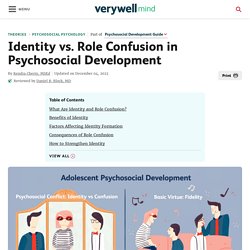

During this complex maturation, adolescents experience various progression, like biological maturity, socialise to gain peer recognition and group membership. And most importantly, their sense of self. This resource set out to examine the rationales and approaches undertaken by adolescents when seeking their self-identity. Adolescence: The Beginning. The Growing Child: Adolescent 13 to 18 Years. How much will my adolescent grow?

The teenage years are also called adolescence. Adolescence is a time for growth spurts and puberty changes. An adolescent may grow several inches in several months followed by a period of very slow growth, then have another growth spurt. Changes with puberty (sexual maturation) may happen gradually or several signs may become visible at the same time. There is a great amount of variation in the rate of changes that may happen. Adolescence is an important time of change. Adolescence: Cultures and Values. Culture and Adolescent Development. Adolescence: Presentation. Youtube. Adolescent Identity Development: What to Expect in Teens. Adolescent Identity Development: The Factors of Change Among the profound and exciting changes taking place in adolescence is the process of self-discovery.
Our teens are working to figure out who they are, making adolescent identity development a central feature of teen life. Adolescence: Perception of Others. Teenage Self-Identity Issues: Causes, Problems, And Common Behaviors. While there are a variety of ways that teens experience identity formation, some experiences can become very harmful to the individual.

In the sections below, we discuss the causes and more serious issues in teenage identity issues & development and how parents can help. Common Causes Contributing to Unhealthy Teen Identity Development The importance of identity development for teens is huge. When a teen is developing their identity they are learning what makes them unique while also feeling the need to fit in. For teens who feel excluded from others due to their cultural, ethnic, gender, or sexual identity, this process can lead teens to begin participating in harmful behavior. Stages of Psychosocial Development Theory: Overview. 8 Stages of Development by Erik Erikson.
Identity versus Role Confusion: Who am I? Erik Erikson’s Identity Crisis: Who am I? Identity vs. Role Confusion in Erikson's Theory. Identity versus confusion is the fifth stage of ego according to psychologist Erik Erikson's theory of psychosocial development.

This stage occurs during adolescence between the ages of approximately 12 and 18. During this stage, adolescents explore their independence and develop a sense of self. The path to self-independence: Adolescence. Teenage Identity Crisis - Who Am I? 7 Tips to Help Your Teen Create a Strong Sense of Self. 7 Tips for Parent’s to Help Their Teen Create a Strong Sense of Self As we welcome in the New Year we also look at goals and new opportunities to explore in the coming year.

A fresh start. Nurturing Self-esteem. Self-esteem is about how we value and love ourselves.

Children with healthy self-esteem have positive outlooks in life and accept themselves for who they are Children with healthy self-esteem are confident, in control and capable of making positive, responsible choices in life. Reference.